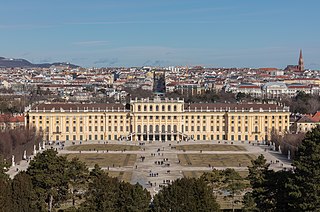 W
WThe Belvedere is a historic building complex in Vienna, Austria, consisting of two Baroque palaces, the Orangery, and the Palace Stables. The buildings are set in a Baroque park landscape in the third district of the city, on the south-eastern edge of its centre. It houses the Belvedere museum. The grounds are set on a gentle gradient and include decorative tiered fountains and cascades, Baroque sculptures, and majestic wrought iron gates. The Baroque palace complex was built as a summer residence for Prince Eugene of Savoy.
 W
WEggenberg Palace in Graz, is the most significant Baroque palace complex in the Austrian province of Styria. With its preserved accouterments, the extensive scenic gardens, as well as some special collections from the Universalmuseum Joanneum housed in the palace and surrounding park, Schloss Eggenberg ranks among the most valuable cultural treasures of Austria. Eggenberg Palace is situated at an elevation of 381 meters on the Western edge of the city. Its architectural design and the still visible imprint of centuries of history continue to bear witness to the vicissitude and patronage of the one-time mightiest dynasty in Styria, the House of Eggenberg.
 W
WHellbrunn Palace is an early Baroque villa of palatial size, near Morzg, a southern district of the city of Salzburg, Austria. It was built in 1613–19 by Markus Sittikus von Hohenems, Prince-Archbishop of Salzburg, and named for the "clear spring" that supplied it. Hellbrunn was only meant for use as a day residence in summer, as the Archbishop usually returned to Salzburg in the evening; therefore, there is no bedroom in Hellbrunn.
 W
WLaxenburg castles are imperial palaces and castles outside Vienna, in the town of Laxenburg owned in equal parts by Vienna and Lower Austria. The castles became a Habsburg possession in 1333 and formerly served as a summer retreat, along with Schönbrunn palace, for the imperial Habsburg dynasty. Blauer Hof Palace was the birthplace of some members of the royal family, including Crown Prince Rudolf. Another castle nearby is named Franzensburg castle.
 W
WThe Liechtenstein Museum is a private art museum in Vienna, Austria. It contains much of the art collection of its owners, the Princely Family of Liechtenstein, rulers of the principality of Liechtenstein. It includes important European works of art, forming one of the world's leading private art collections. Its highlight used to be Leonardo da Vinci's portrait of Ginevra de' Benci, which was acquired in 1967 by the National Gallery of Art in Washington, D.C.
 W
WNeugebäude Palace is a large Mannerist castle complex in the Simmering district of Vienna, Austria. It was built from 1569 onwards, at the behest of the Habsburg emperor Maximilian II. The site of the palace is said to be where the Ottoman Sultan Süleyman the Magnificent's tent was erected during the 1529 Siege of Vienna. The palace was apparently modeled after it.
 W
WSchallaburg Castle is a castle in the village of Schallaburg in the municipality of Schollach, near the Wachau valley, Lower Austria, north of the Alps. Schallaburg Renaissance Castle is 5 kilometres (3 mi) from Melk, in the region known as Mostviertel. The central part of the castle was built in the German Renaissance Age, beginning around 1540, by the Losenstein dynasty.
 W
WSchloss Esterházy is a palace in Eisenstadt, Austria, the capital of the Burgenland state. It was constructed in the late 13th century, and came under ownership of the Hungarian Esterházy family in 1622. Under Paul I, 1st Prince Esterházy of Galántha the estate was converted into a baroque castle which remained the principal residence and center of administration of the family for over 300 years.
 W
WSchloss Hof is a palace located in Marchfeld, Austria near the border of Slovakia. It once belonged to Prince Eugene of Savoy who purchased it late in his life in 1726. He had it enlarged in the Baroque style by the architect Johann Lukas von Hildebrandt in 1729, and used it as an elaborate hunting lodge. He left it to a niece in his will, and it was later purchased by Empress Maria Theresa of Austria and became part of the imperial estates.
 W
WSchönbrunn Palace was the main summer residence of the Habsburg rulers, located in Hietzing, Vienna. The name Schönbrunn has its roots in an artesian well from which water was consumed by the court.
 W
WThe sculptures in the Schönbrunn Garden at Schönbrunn Palace in Vienna, Austria were created between 1773 and 1780 under the direction of Johann Wilhelm Beyer, a German artist and garden designer. The Great Parterre of Schönbrunn Garden is lined on both sides with 32 over life-size sculptures that represent mythological deities and virtues. The Neptune Fountain at the foot of the Gloriette hill is the crowning monument of the Great Parterre. Other sculptures are distributed throughout the garden and palace forecourt, including fountains and pools. Several sculptors were employed during the execution of these works, among them Johann Baptist Hagenauer.
 W
WThe Universalmuseum Joanneum is a multidisciplinary museum with buildings in several locations in the province of Styria, Austria. It has galleries and collections in many subject areas including archaeology, geology, paleontology, mineralogy, botany, zoology, history, art and folk culture. It is the oldest museum in Austria as well as the largest universal museum in central Europe with over 4.5 million objects in 13 departments and 12 locations in the Styrian cities of Graz, Stainz, Trautenfels, and Wagna. To reflect this status and its growth over the last two centuries, as well as to present a more recognizable image internationally, the Landesmuseum Joanneum was officially renamed to Universalmuseum Joanneum on 10 September 2009.